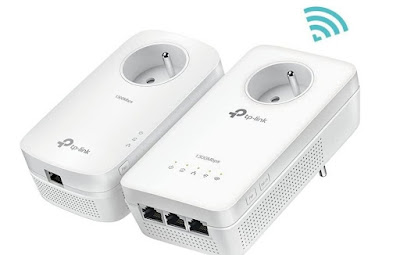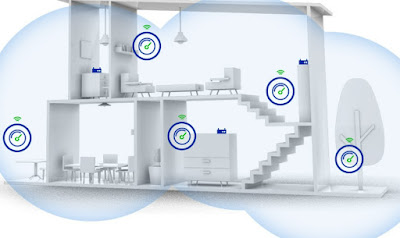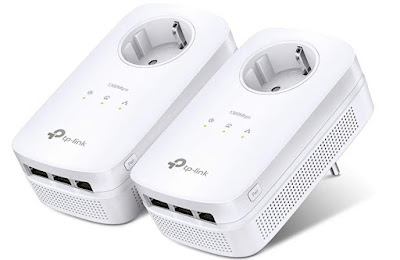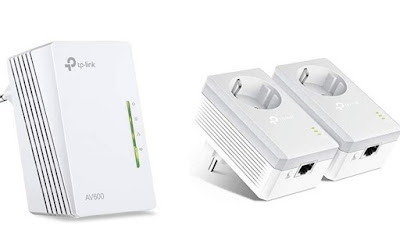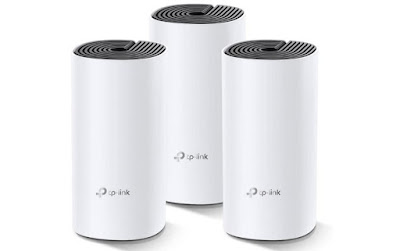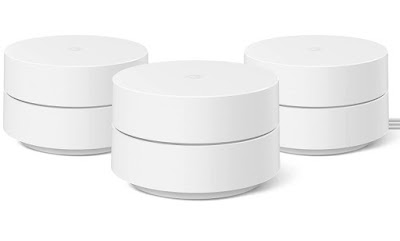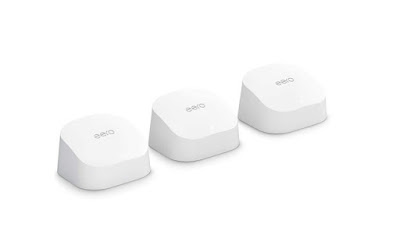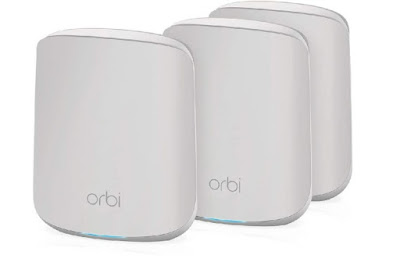The home connection does not take in all rooms? Let’s see which technology to choose between Powerline and Wi-Fi Mesh to extend coverage.
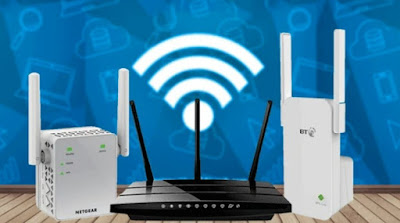 When the home connection does not cover all the rooms or we have difficulty connecting to a specific point in the house, we can expand network coverage using cutting-edge technologies such as the Powerline and, more recently, the Wi-Fi Mesh, with the latter effectively retiring the old (still good but outdated) Wi-Fi amplifiers. But which one should you bet on? Which guarantees the best connection at all times? Which is cheaper?
When the home connection does not cover all the rooms or we have difficulty connecting to a specific point in the house, we can expand network coverage using cutting-edge technologies such as the Powerline and, more recently, the Wi-Fi Mesh, with the latter effectively retiring the old (still good but outdated) Wi-Fi amplifiers. But which one should you bet on? Which guarantees the best connection at all times? Which is cheaper?
If we are undecided between the two technologies, we have come to the right guide: in the following chapters we will show you which ones are pros and cons of Powerline and Wi-Fi Mesh, so you can compare them and choose which one to rely on only after carefully evaluating everything.
READ ALSO -> Amplify your home Wi-Fi and extend wireless reception
What is Powerline: strengths and weaknesses
With Powerline we identify the technology that allows surf the Internet using the electrical sockets at home. By connecting two adapters to as many electrical sockets we will create a real “bridge”, with the connection data traveling in the electrical wires without interfering with the normal electrical flow (the one that powers the electrical devices).
To the primary adapter we will have to connect an Ethernet network cable coming from the modem, while to the secondary adapter we will connect the device to be connected to the Internet (always with an Ethernet cable). In fact it is like connecting directly to the modem via cable: the data travels encrypted between the two Powerlines, using a dedicated protocol.
We can also connect other secondary Powerline to this solution, so as to also connect other devices (the primary one is always only one and is connected to the modem) and expand the Powerline network. Some Powerline models also offer Wi-Fi on the secondary device, so you can also connect Wi-Fi devices; on still other models there is also an electric socket, so as not to lose the socket where we use the Powerline.
The advantages of this solution are very obvious:
- Economic: Powerline devices are relatively inexpensive and we can connect even more than two, maintaining a much lower price than the Wi-Fi Mesh.
- Simple to use: in most cases it will be enough to insert the two Powerline into the wall socket, wait a few seconds and insert the Ethernet cables, so as to have the connection immediately without pressing any button.
- Resistant to interference: traveling on electric wires it is less subject to interference than the electromagnetic waves used by the Wi-Fi Mesh.
- Less harmful: since all data travels via cable, we will avoid using too many electromagnetic waves, leaving the modem’s Wi-Fi active at maximum.
Unfortunately, the Powerline technology brings with it very pronounced defects, which in fact have limited its spread:
- Dependence on the quality of the electricity network: if we have new and well-shielded electrical wires in our house, the Powerline will work fine; but if we have old or unshielded wires the Powerline signal will have a hard time making the data travel, causing low transmission speeds and real connection blocks.
- Tendency to overheatPowerline devices tend to overheat easily due to the nature of the technology. In summer it is also possible to run into real locks or restarts of the devices, necessary to maintain operation and avoid breakage.
- Low transmission speed: the transmission speed between the two Powerlines tends to be influenced by the quality of the cables, by the presence of other devices with high electrical absorption and by the distance of the electricity meter. On average, we travel at 50-60 Megabits per second in the best conditions, a lower value than the Wi-Fi Mesh.
- Busy socket: Unless we buy the models with a pass-through electrical outlet, using the Powerline will permanently occupy two electrical outlets, to which we cannot connect anything else.
If we still have doubts about Powerline we can also read ours Powerline guide, so as to discover the operating protocols and the tricks to always connect at maximum speed.
What is Wi-Fi Mesh: strengths and weaknesses
Wi-Fi Mesh is a next-generation technology available as an upgrade to older Wi-Fi networks. With Wi-Fi Mesh we will have more interconnected access points, which are all used together for data transport: in fact, every device connected to the Wi-Fi Mesh will get fast connection speeds even over long distances, since the data always follows the best path to get to the modem.
By using two or more Wi-Fi Mesh devices we will therefore be able to cover even the largest houses, traveling on the Internet at maximum speed even several meters away from the modem. Also in this case there is a primary access device, which must be connected via Ethernet cable to the modem; the other devices that make up the Wi-Fi Mesh kit (called satellites) can be placed in strategic points of the house, so as to expand the network coverage with absolute efficiency.
The advantages of Wi-Fi Mesh are:
- High speed: by connecting to a Mesh Wi-Fi network we will have the maximum possible transmission speed, with download and upload speeds comparable to direct connection via cable to the modem (using 5 GHz Mesh Wi-Fi networks).
- Extended coverage: the modern three-unit Wi-Fi Mesh kits allow you to cover an area of 300 square meters, sufficient even for larger homes or villas with gardens.
- Continuity of service: by using multiple Wi-Fi Mesh modules we will be able to continue browsing even if one of the modules stops working, since traffic will be diverted to the closest working module. Of course, coverage will decrease in this scenario, but with any luck we will still get enough signal to surf the Internet.
- Expandability: by purchasing other modules of the same Wi-Fi Mesh model we can easily increase the coverage, following the wizard for association with an existing Wi-Fi Mesh network.
- Powerline functionality: Individual satellites often also have an Ethernet socket, so that a PC or other device can be connected via cable without using the wireless network.
Unfortunately, this new technology also has disadvantages:
- Cost: at the moment Wi-Fi Mesh kits tend to be much more expensive than Powerline kits, especially with models equipped with three units (those useful for covering larger areas). Thankfully, the prices of these devices are going down over time, so one day the prices are likely to align.
- Greater electricity consumption: each Wi-Fi Mesh module needs an electrical socket, so in addition to occupying the sockets we must also take into account the energy consumption of the whole system (which could be much higher than the Powerline).
- Possible interference: expanding your network coverage exposes the network itself to greater interference, since it increases the likelihood of encountering neighbors’ networks (which in fact overlap with electromagnetic waves). To minimize interference, it is advisable to use only 5 GHz networks even with Wi-Fi Mesh.
- Electromagnetic pollution: with Wi-Fi Mesh we will have 3 units or more that continuously emit electromagnetic waves, which are added to those already present with the modem and the other devices we use (such as phones). People sensitive to this aspect should consider whether to focus on Wi-Fi Mesh, perhaps choosing kits with only two units.
In our dedicated guide we can find out closely all the secrets of Wi-Fi Mesh.
Powerline: best models to buy
Have we decided to focus on Powerline technology? To start exploiting it right away, we can focus on TP-Link TL-WPA7517, from 70 Euros.
This Powerline kit supports the HomePlug AV2 1000 protocol (up to 1000 Mbps on the electrical network), has Dual Band AC WiFi up to 750 Mbps, has 1 Gigabit Port on both adapters and is Plug and Play, i.e. it is ready to use. use as soon as the two devices are connected.
If, on the other hand, we are looking for a Powerline kit with a pass-through electrical outlet, we can see the TP-Link TL-PA8030P from 100 Euros.
In this kit we find support for the HomePlug AV2 1300 protocol (up to 1300 Mbps on the electrical network), support for Green Powerline technology, Qualcomm processor, electrical outlet and 3 Gigabit Ethernet ports for each adapter.
For very large houses it may be useful to focus on a kit consisting of three adapters such as the TP-Link TL-WPA4220 from 90 Euro.
With this trio of adapters we can cover very large areas of the same house, using the Wi-Fi adapter to cover the most remote areas and the two adapters with pass-through socket to cover the rooms where we have fixed PCs, decoders or consoles. These adapters support the AV600 protocol and support Wi-Fi Extender functionality with Wi-Fi Clone and Wi-Fi Auto-Sync.
Wi-Fi Mesh: Best Models to Buy
If for our needs we must necessarily focus on Wi-Fi Mesh, it is advisable to immediately focus on models with 3 modules such as the TP-Link Deco M4, from 150 Euros.
This kit features support for AC1200 Dual Band Wi-Fi technology, 2 Gigabit Ethernet ports for each satellite, Router and Access Point Mode, Parental Control system, device control via app and coverage up to 370 square meters.
One of the best Wi-Fi Meshes we can bet on is provided by Google with Google Nest Wifi from about 200 Euros.
With these simple and elegant devices we can bring the Internet to every corner of the house thanks to the support for Dual Band Wi-Fi, two Ethernet ports for each device, quick connection and management of functions via the Google Home app, management via voice assistant and up to 255 square meters of effective coverage.
Amazon also made its own Mesh Wi-Fi system: Amazon Eero 6, a really elegant and sober kit, from Amazon, from 160 Euros (if including router).
The kit provided by Amazon supports Internet connection up to 500 Mbps, provides the Wi-Fi connection 6 to connect the latest generation devices, it supports traditional dual band Wi-Fi connections and provides a support app (eero) to manage every aspect of the network (coverage, connected devices and security). This kit allows you to cover up to 460 square meters.
The most expensive Wi-Fi Mesh kit we can get our hands on is the NETGEAR Orbi Mesh RBK353 a 300 Euro.
In this kit we find Router with support for WiFi 6 technology, 2 ready-to-use mesh extenders, support for WiFi 6 AX1800 technology, support for traditional Dual Band Wi-Fi networks, dedicated management via app and coverage up to 300 square meters.
Conclusions
If we do not know which one to choose between the two technologies, we advise you to focus on Wi-Fi Mesh: even if we spend more money we will have a higher network coverage and we will be able to connect many Wi-Fi devices even from the most distant areas of the house. Powerline is a valid technology but it also needs good electrical cables: if we live in a new house that is not too big we can consider Powerline adapters to connect consoles, Smart TVs, fixed PCs or decoders.
For those who still have problems bringing the Wi-Fi signal throughout the house, you can also read our in-depth articles to bring the Internet to every floor of a large house and how enhance the wifi signal that always disconnects.

